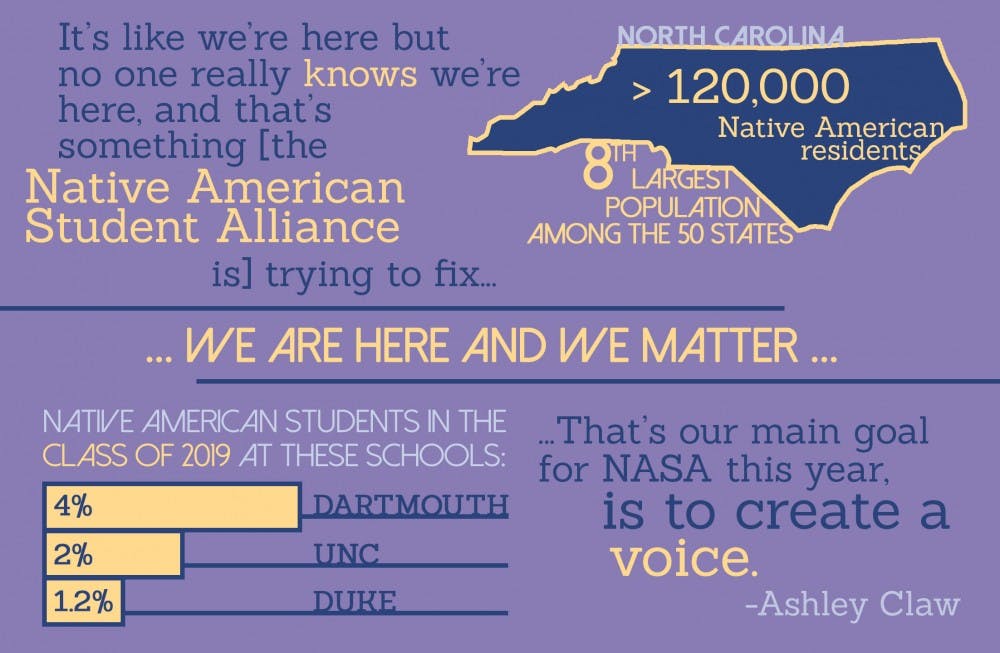Although North Carolina has the second-largest Native American population of any state east of the Mississippi River, Native representation among students and faculty is notably small.
Native American students make up less than one percent of students at Duke as of 2014. Representation can be a challenge for a demographic that makes up approximately 1.7 percent of the U.S. population, according to the 2010 U.S. Census. This year, the Native American Student Alliance, or NASA, aims to increase the visibility of Native American students on campus.
“When I say that I’m Native American—I introduce myself that way because I’m proud to say it—[people] say, ‘oh, you’re Native American! You’re the first one that I’ve ever met!’” said sophomore Ashley Claw. “I’m kind of proud to be that first person, but then again, that kind of makes me sad.”
The most notable event organized by NASA is the annual powwow on the Main Quadrangle, which was first held in 2001 and features drum circles and dancers in traditional dress. Although the event was not held last year due to a lack of membership, Claw and sophomore Taylor Miller, co-presidents of NASA, hope to bring it back this year. They also plan on presenting books by Native authors to the summer reading selection committee, “to get the word out to Duke that there are Native students here,” Claw said.
NASA lists one of its goals as fighting outdated notions of Native American life and culture.
“A lot of Americans and people around the world still either imagine Native Americans have disappeared or are riding around the Great Plains on horseback, hunting buffalo with a bow and arrow,” wrote Orin Starn, professor of cultural anthropology and former faculty advisor for NASA, in an email.
Another challenge Native students face is the pressure to succeed, Claw said, which is amplified not only by the relative scarcity of Native American students at Duke, but by the low graduation rates at colleges throughout the country.
“There’s not many Natives who go to college, or pursue higher education,” Claw said. “That’s something that’s always in the back of my mind, even though it really shouldn’t be. It pushes me to work harder.”
Starn wrote that the low college graduation rate among Native Americans is partly due to “underfunded reservation schools that don’t adequately prepare kids for college.”
Part of the problem lies with the lack of Native American faculty at Duke, he noted.
“Unless this has changed in the last few years, there has never been a single Native American faculty member in Duke’s history,” Starn wrote. “It’s really embarrassing and reflects badly on us as a university.”
Starn noted that some of Duke’s peer institutions—in particular Dartmouth and Stanford—are more appealing to Native American students for a number of reasons, including more native faculty, higher percentages of Native students, and larger Native American Studies programs. Four percent of students in the class of 2019 at Dartmouth identify as Native American—compared to just 1.2 percent of the class of 2019 at Duke, according to NASA.
“UNC does much better than Duke in Native American student recruitment, especially of Lumbee and other groups from North Carolina,” Starn wrote.
Two percent of the class of 2019 at the University of North Carolina at Chapel Hill is Native American.
With more than 120,000 Native Americans according to the 2010 census, North Carolina has the eighth-largest population of Native American citizens among all states.
“You would think that since North Carolina has a huge Native American population we would be stronger, but it’s really the opposite, which is kind of weird,” Miller said.
NASA originated in 1992 as the Native American Student Coalition and became the Native American Student Alliance in 2003. The organization had only three active members last year, Claw said. She added that more than 10 students attended this year’s welcome meeting, a sign that NASA could have a greater presence at Duke going forward.
“It’s like we’re here but no one really knows we’re here, and that’s something [Miller and I] are really trying to fix—to get people to understand that we are here and we matter,” Claw said. “That’s our main goal for NASA this year, is to create a voice.”

